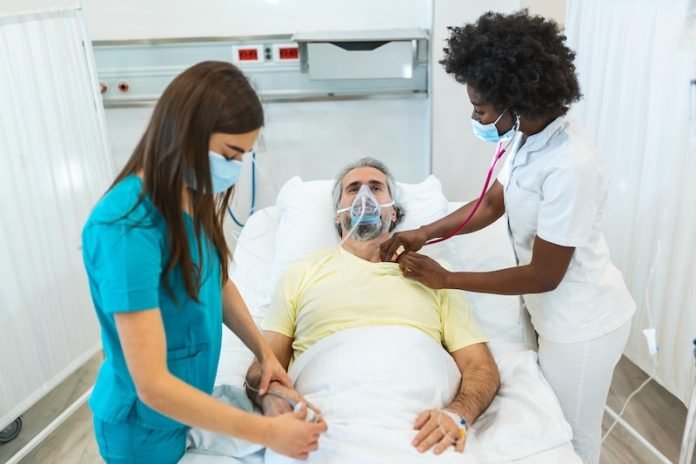
Scientists at Northwestern University Feinberg School of Medicine found the real cause of the deaths in COVID-19 patients.
They used machine learning to analyze medical records of patients with COVID-19 and found that almost half of them who required mechanical ventilation also developed a secondary bacterial infection of the lung (pneumonia).
This secondary pneumonia was a key driver of death in patients with COVID-19 and may even exceed death rates from the viral infection itself.
The study found that patients who were cured of their secondary pneumonia were more likely to live, while those whose pneumonia did not resolve were more likely to die.
This suggests the importance of preventing, looking for, and aggressively treating secondary bacterial pneumonia in critically ill patients with severe pneumonia, including those with COVID-19.
The researchers used a new machine learning approach called CarpeDiem, which groups similar ICU patient days into clinical states based on electronic health record data.
This novel approach allowed them to analyze how complications like bacterial pneumonia impacted the course of illness.
The study analyzed 585 patients in the ICU, 190 of whom had COVID-19.
The researchers found that the mortality related to the virus itself is relatively low, but other things that happen during the ICU stay, like secondary bacterial pneumonia, offset that.
The study findings also negate the cytokine storm theory, which means an overwhelming inflammation that drives organ failure in your lungs, kidneys, brain, and other organs.
If cytokine storm were underlying the long length of stay seen in patients with COVID-19, researchers would expect to see frequent transitions to states that are characterized by multi-organ failure.
However, that’s not what they saw in this study.
The next step in the research will be to use molecular data from the study samples and integrate it with machine learning approaches to understand why some patients go on to be cured of pneumonia and some don’t.
Researchers also want to expand the technique to larger datasets and use the model to make predictions that can be brought back to the bedside to improve the care of critically ill patients.
In summary, the study highlights the importance of preventing, looking for, and aggressively treating secondary bacterial pneumonia in critically ill patients with severe pneumonia, including those with COVID-19.
The findings also suggest that the mortality related to the virus itself is relatively low, but other things that happen during the ICU stay, like secondary bacterial pneumonia, offset that.
The study demonstrates the potential of using machine learning and artificial intelligence to develop better ways to treat diseases like COVID-19 and to assist ICU physicians in managing these patients.
How to prevent severe COVID-19
There are several things that people can do to reduce their risk of severe COVID-19:
Get vaccinated: Vaccines are one of the most effective ways to prevent severe COVID-19. They help the body develop immunity against the virus, reducing the risk of hospitalization, severe illness, and death.
Wear a mask: Wearing a mask can reduce the spread of the virus and protect others. It’s particularly important to wear a mask in crowded places or when it’s difficult to maintain social distancing.
Wash hands frequently: Washing hands frequently with soap and water or using hand sanitizer can help prevent the spread of the virus. Make sure to wash your hands for at least 20 seconds.
Practice social distancing: Social distancing means staying at least 6 feet away from others. This can help prevent the spread of the virus, particularly in crowded places.
Avoid large gatherings: Large gatherings can increase the risk of COVID-19 transmission. It’s best to avoid them altogether, particularly if there are people who are not vaccinated.
Stay home if sick: If you have symptoms of COVID-19, stay home and seek medical advice. This can help prevent the spread of the virus to others.
Manage underlying health conditions: People with underlying health conditions, such as diabetes, obesity, and heart disease, are at a higher risk of severe COVID-19.
It’s important to manage these conditions and follow any treatment plans recommended by your healthcare provider.
Take care of your overall health: Eating a healthy diet, getting enough sleep, and exercising regularly can help support a healthy immune system, which can reduce the risk of severe COVID-19.
By following these measures, people can help protect themselves and others from severe COVID-19. It’s important to continue to follow public health guidelines and recommendations to help control the spread of the virus.
If you care about eye health, please read studies that diabetes and high blood pressure can predict blinding eye disease, and 7 habits that help prevent vision loss in older people.
For more information about COVID, please see recent studies about new evidence on rare blood clots after COVID-19 vaccination, and results showing zinc could help reduce COVID-19 infection risk.
The study was conducted by Catherine A. Gao et al and published in the Journal of Clinical Investigation.
Copyright © 2023 Knowridge Science Report. All rights reserved.



